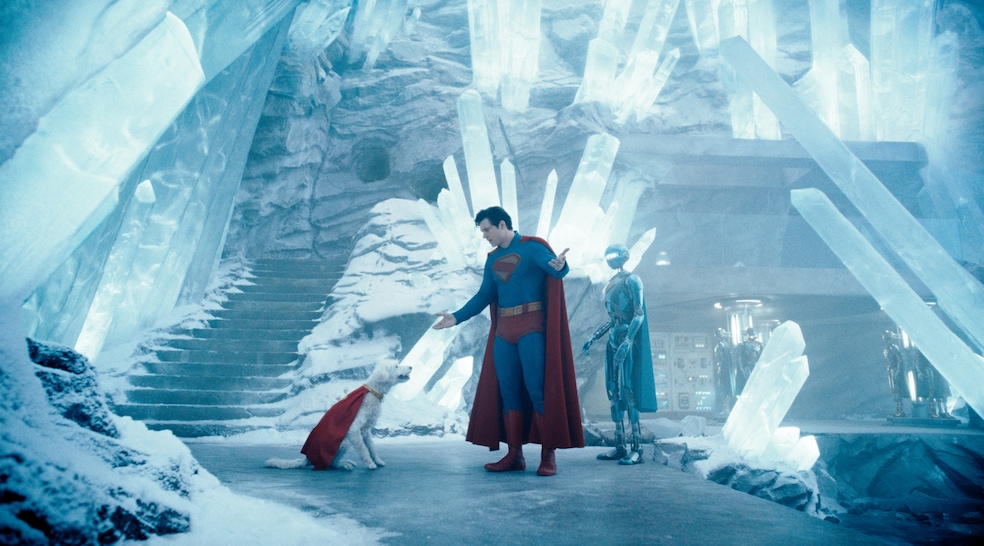Superman is back as the star of his own big-screen adventure for the first time in 12 years. New face, new Lois, new (to the movies) dog, but he brought his old house with him.
The man of steel’s Fortress of Solitude is featured prominently in trailers for the new flick, which hit theaters Friday, and from what audiences can glean, director James Gunn is sticking with the pointy Arctic ice palace made out of Kryptonian crystals introduced in Richard Donner’s 1978 classic.
(Director Zack Snyder reimagined the fortress as a crashed Kryptonian ship in 2013's "Man of Steel.")
But what would Superman’s hideout look like if he built it in the U.S. and had to use contractors instead of omnipotent alien minerals?
Architect Chad Oppenheim, founder of Oppenheim Architecture with offices in Miami and Switzerland, is willing to take on the job. “If anyone wants to build it, I’m ready,” he said.
Oppenheim is also the editor of “Lair: Radical Homes and Hideouts of Movie Villains.” The book features art and descriptions of bad guy abodes, from James Bond antagonist Ernst Starvo Blofeld’s volcano base to the Death Star from "Star Wars."
Even Lex Luthor’s abandoned subway station in the first Superman movie gets a look. “It was like a flooded hall,” Oppenheim said. “With that pool? That was freaking cool.”
But Oppenheim, who famously designed director Michael Bay’s L.A. villa, said he’s got no allegiance to the scoundrel side. “I’m agnostic,” he said. “I work for superheroes and supervillains. Anyone who wants super good architecture.”
But where would Superman build his lair?
Before the secret doors and interdimensional gateways can be planned, the Superman project has to be sited.
The Fortress’s history in the comics is more complicated than the movies. The first time it appeared, it was carved into mountains outside Metropolis, so a real-world equivalent might be dug into the Catskills. But there are probably too many resorts in the area for Superman to sneak in and out undetected.

One might be tempted to work in northern Alaska to get back into the tundra. But the goal isn’t ice. (In the comics, the Fortress has also been in the Amazon rainforest and the Andes mountains.) The goal is solitude.
“A lair is a place where an animal hides,” Oppenheim said.
Monowi, Nebraska, is a town with exactly one resident, according to the Census Bureau, which sounds pretty isolated until you realize the village is less than a quarter of a square mile big. There’s no way not to talk to the only other person there.
The least populated county per square mile in the U.S. is Loving, Texas, a barren, rocky desert on the southern border of New Mexico with 677 square miles to choose from (roughly three-fifths the size of Rhode Island) and only 64 people to dodge, according to the 2020 Census.
Oppenheim has ideas for the desert. “I would have it carved into the ground and build full subterranean,” he said.
One of the traits Oppenheim most wants to replicate from the movie’s take is for the Fortress to use its environment. “What I liked about it was that it was built out of [the ice],” he said. “It transformed the materials around it.”
While it hasn’t ever appeared in the movies, Superman’s Fortress also has a key, once disguised as an aircraft path marker (a big arrow on the ground) that only he could lift and operate. Oppenheim sees a similar solution for a signature entrance to the "Big Blue Boy Scout's" new home.
“The obvious thing would be to have a large boulder that only he can move,” he said.

Conforming buildings to the features of the desert is familiar to Oppenheim, who built Desert Rock in Saudi Arabia. The ecotourism resort blends into the mountains and sands around it.
For Superman, Oppenheim would go deeper. “I like the idea of burrowing into rock and creating a subterranean cathedral to superhuman power,” he said.
Oh, and Clark. He gets a room all his own.
The Fortress needs rooms for Supes’ friends, such as Lois Lane, Jimmy Olsen, and Perry White. In the books, there’s even one for Clark Kent to confuse visitors. It also houses an alien zoo, a lab, and a gym. (Superman depowers himself with technology and works out, then adds his powers back.)
Oppenheim doesn’t necessarily know where he might get something like a Phantom Zone projector, but he does have an idea of how he would get the necessary space.
“I would be subtractive of space instead of additive,” he said. “Basically, carve like a kid on the beach deep into the earth to create something dramatic and with incredible volume.”
Oppenheim finds building in rock inspiring. In fact, it was the villain’s lair in “The Man With the Golden Gun,” which was carved into rocky South Pacific islands, that first got the architect interested in hideouts. “I’m sitting there in suburban New Jersey, and I see that, and it blew my mind.”
What he would want to give Superman's hideout are the same sort of features that drew him to love the other lairs.
“Everything had to be desirous and aspirational,” he said, “and it had to be architecturally interesting as well.”
To quote Superman: "Sometimes you have to take a leap of faith first. The trust part comes later."
